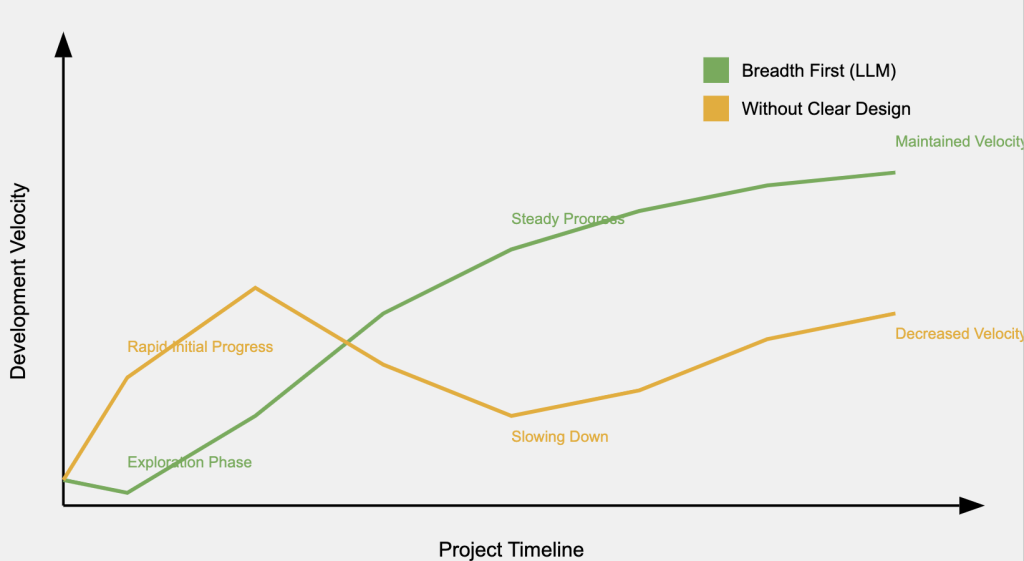Imagine you’re an architect tasked with designing a sprawling cityscape. Would you start by meticulously crafting a single building, or would you first sketch out the entire city’s layout? In the world of software development, a revolutionary approach is gaining traction that mirrors this bird’s-eye view strategy. Welcome to the AI-assisted “breadth-first” approach – a game-changing methodology that’s reshaping how we build complex software systems.
The Breadth-First Revolution
Inspired by the Breadth-First Search algorithm from AI and graph theory, this approach leverages artificial intelligence to help developers create a high-level overview of their entire project before diving into the nitty-gritty details. It’s like having an AI co-pilot that helps you map out your software city before you start constructing individual buildings.
Here’s how it typically unfolds:
- Sketch the big picture: Use AI to brainstorm and outline your entire feature set.
- Build the skeleton: Let AI help generate a basic project structure and hierarchy.
- Wire it up: Implement placeholder logic to visualize how different parts will interact.
- Fill in the details: Gradually replace placeholders with actual implementations.
This approach is turning heads in the industry, and for good reason. Take Spotify, for example. While they haven’t publicly disclosed using this exact method, their microservices architecture and rapid prototyping approach align closely with breadth-first principles. By focusing on the overall system design before diving deep into individual services, Spotify has built a highly scalable and flexible platform that can quickly adapt to new features and changing user needs. Several of us in the Generaite Labs discord are coming to similar conclusions, that up-front work to get the project together in a “walking skeleton” results in better outcomes.
The Breadth-First Advantage
So, why are developers getting excited about this approach? Let’s break it down:
Rapid Prototyping: Imagine going from concept to working prototype in days instead of weeks. That’s the power of AI-assisted breadth-first development.
Improved Architecture: By seeing the big picture early, you’re less likely to paint yourself into a corner with poor design choices.
Early Issue Detection: Spot potential conflicts between components before they become costly problems.
Flexibility: Prioritize and pivot on the fly as requirements change or new insights emerge.
Developer Understanding: you need to understand the code and be close and connected to it, line by line. By scaffolding the project, you’ll understand the problem. Even if you have to scrap your work and start over after a first run at it, you’ll have the knowledge to make the right decisions after going through the design once.
But it’s not all smooth sailing. As with any new approach, there are challenges to navigate:
Context Management: Keeping your AI assistant up-to-date on the project state can be a juggling act.
Balancing Act: Finding the sweet spot between AI assistance and human expertise is crucial.
Complexity Overload: For massive projects, even a high-level view can become overwhelming. I’m finding it’s easier to manage the complexity after taking a pass at scaffolding the project as I understand everything after that first run.
Upfront Cost: Stakeholders might get nervous if they don’t see the feature development early, because your focus will be on the broader scope first. Similar to doing design before building, there is an upfront cost that pays off later.

Tools of the Trade
To implement this approach effectively, you’ll need the right tools in your arsenal:
- Large Language Models: GPT-4 or Anthropic’s Claude can help generate code, documentation, and even architectural diagrams.
- AI-Enhanced IDEs: Tools like GitHub Copilot or Tabnine provide real-time coding suggestions.
- Automated Code Review: Solutions like DeepCode or Amazon CodeGuru can spot issues across your entire codebase.
- Visualization Tools: Mermaid.js, when combined with AI, can help create and update system diagrams on the fly.
A Real-World Success Story
While many companies are still in the early stages of adopting this approach, some pioneers are already seeing results. Consider the case of Airbnb. While they haven’t explicitly labeled their process as “breadth-first,” their approach to building their expansive platform shares many similarities.
Airbnb’s engineering team uses a combination of AI-assisted tools and custom-built solutions to manage their complex, microservices-based architecture. By focusing on the overall system design and using AI to help generate boilerplate code and API specifications, they’ve been able to rapidly prototype and iterate on new features across their platform.
This approach has allowed Airbnb to maintain a high pace of innovation while managing a system that spans multiple platforms and serves millions of users worldwide. It’s a testament to the power of thinking broad before going deep.
The Road Ahead
As AI continues to evolve, we can expect the breadth-first approach to become even more powerful. Imagine AI assistants that can not only help sketch out your project but also predict potential scalability issues or suggest optimal architectural patterns based on your specific requirements.
However, it’s crucial to remember that AI is a tool, not a replacement for human creativity and expertise. The most successful implementations of this approach will likely come from teams that find the right balance between AI assistance and human insight.
As we stand on the brink of this AI-powered revolution in software development, one thing is clear: the days of building complex systems by focusing on one component at a time are numbered. The future belongs to those who can see the forest and the trees – and with AI as our co-pilot, that future is closer than ever.
So, are you ready to take a bird’s-eye view of your next project? The AI-assisted breadth-first approach awaits, promising a new era of faster, more flexible, and more robust software development. The question isn’t whether you’ll join this revolution, but when. The future of coding is here – and it’s broader than ever before.


